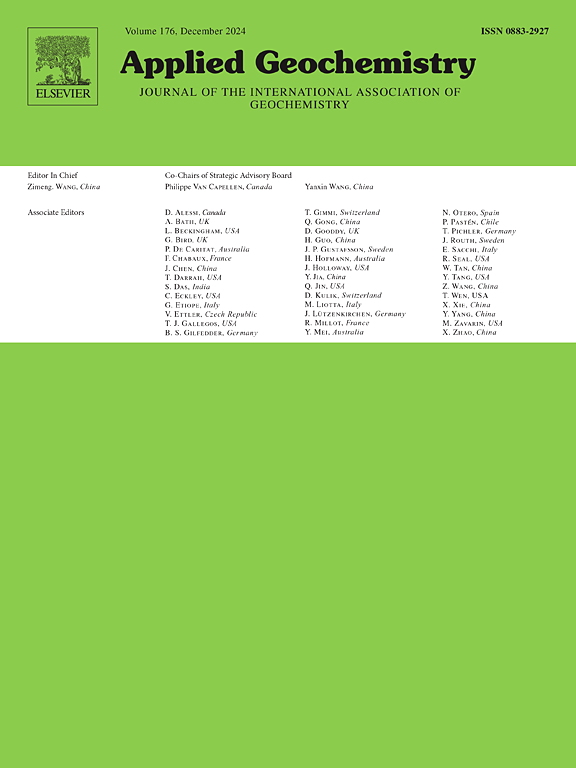铅污染酸性湿地修复效果及季节变化
IF 3.4
3区 地球科学
Q1 GEOCHEMISTRY & GEOPHYSICS
引用次数: 0
摘要
在26个月的时间里,在一个自然酸性污染的湿地中测试了三种原位铅(Pb)土壤改良剂处理方法,目的是将高水平的铅污染作为稳定的矿物形式隔离。其中两种处理使用磷灰石II,一种磷酸盐基改进剂,以促进焦闪石的形成。一种方法是表面施用磷灰石改良剂,另一种方法是物理混合到表层土壤中。第三次处理采用了富含硫酸盐的堆肥混合物,目的是促进方铅矿的形成。通过比较不同处理间的Pb孔隙水浓度,以及通过x射线吸收光谱(XAS)测定沉积物Pb形态的变化来评估修正效果。结果表明,施用后2年内,3种处理对铅的迁移和形态形成均无显著影响。与对照区相比,处理区溶解铅浓度没有显著降低。此外,物种形成分析没有显示磷酸盐修正地块中有焦闪石形成的证据。在富硫酸盐堆肥的第三个处理中发现了方铅矿,但其意义受到样本量和湿地其他区域方铅矿存在的限制。铅的形成存在季节变化,方铅矿和铅半胱氨酸在雨季结束时更为普遍,而在旱季结束时较少,这表明虽然诱导形成还原性铅硫物种是可能的,但在不同时控制土壤水分饱和度的情况下维持这些物种存在挑战。这项研究表明,有效的修复处理必须考虑到特定地点的特征,如pH和氧化还原动力学,并使用适当的保存方法来获得准确的物种形成结果。本文章由计算机程序翻译,如有差异,请以英文原文为准。

Amendment effectiveness and seasonal variations in a lead contaminated acidic wetland
Three in-situ lead (Pb) soil amendment treatment methods were tested over 26 months in a naturally acidic contaminated wetland with the intent of sequestering high levels of Pb contamination as stable mineral forms. Two of the treatments used Apatite II, a phosphate-based amendment, to promote the formation of pyromorphite. The apatite amendment was surface applied one method and physically mixed to the surface soils in the other. A sulfate-rich compost-based mixture was used for the third treatment, with the goal to promote the formation of galena. Amendment effectiveness was evaluated by comparison of Pb porewater concentrations between treatments, and by changes in the speciation of sediment Pb as determined by X-ray absorption spectroscopy (XAS). Results show that in the two years following application, the three treatments did not make a significant impact on Pb mobility and speciation. Dissolved Pb concentrations did not decrease significantly in the treatment plots in comparison to the control plots. Furthermore, speciation analysis did not show evidence of pyromorphite formation in the phosphate-amended plots. Galena was found in the third treatment with sulfate-rich compost, however the significance of this was limited by sample size and the presence of galena in other areas of the wetland. There was a seasonal variation in the Pb speciation, with galena and Pb-cysteine being more prevalent at the end of the wet season and less prevalent at the end of the dry season, indicating that while the induced formation of reduced Pb-sulfur species is possible, there are challenges to maintaining those species without concurrent control of soil water saturation. This study shows that effective amendment treatments must account for site-specific characteristics such as pH and redox dynamics, and use appropriate preservation methods for accurate speciation results.
求助全文
通过发布文献求助,成功后即可免费获取论文全文。
去求助
来源期刊

Applied Geochemistry
地学-地球化学与地球物理
CiteScore
6.10
自引率
8.80%
发文量
272
审稿时长
65 days
期刊介绍:
Applied Geochemistry is an international journal devoted to publication of original research papers, rapid research communications and selected review papers in geochemistry and urban geochemistry which have some practical application to an aspect of human endeavour, such as the preservation of the environment, health, waste disposal and the search for resources. Papers on applications of inorganic, organic and isotope geochemistry and geochemical processes are therefore welcome provided they meet the main criterion. Spatial and temporal monitoring case studies are only of interest to our international readership if they present new ideas of broad application.
Topics covered include: (1) Environmental geochemistry (including natural and anthropogenic aspects, and protection and remediation strategies); (2) Hydrogeochemistry (surface and groundwater); (3) Medical (urban) geochemistry; (4) The search for energy resources (in particular unconventional oil and gas or emerging metal resources); (5) Energy exploitation (in particular geothermal energy and CCS); (6) Upgrading of energy and mineral resources where there is a direct geochemical application; and (7) Waste disposal, including nuclear waste disposal.
 求助内容:
求助内容: 应助结果提醒方式:
应助结果提醒方式:


